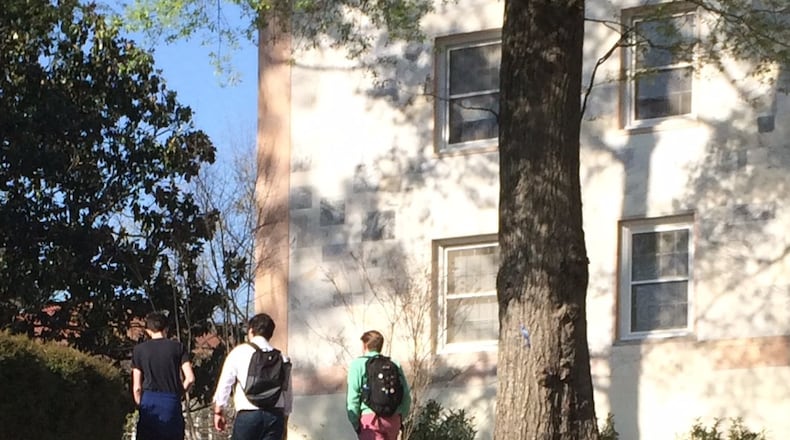This week, I was invited into the Latino students’ “safe space” at Emory University to talk about fear and loathing brought on by a serial Trump chalker on campus. I know, it sounds ridiculous, sort of like an Onion story come to life.
The story is now well-known. I just finished reading a British newspaper’s take on it.
Sometime late Sunday, someone wandered the decidedly liberal campus “chalking” sidewalks and walls with pro-Trump slogans. Come daylight, a pack of chanting students converged on the university president’s office, complaining about the anxiety and despair brought about by the midnight chalker.
The story quickly made the rounds as the latest example of easily offended students being whipped into a frenzy, of suffering “microaggression.”
By comparison, a student downtown at Georgia State University was involved in a macroaggression Monday: He allegedly was selling pot to somebody and got in a shootout with the buyer. Both were shot. So pick your weapon, a pistol or chalk.
Word that students in this expensive bastion of higher education got so offended by just the thought of The Donald made the Internet explode. Denunciations of the students came by the megabyte — “Snowflakes.” “Humorless punks.” “Pathetic weaklings.”
“It’s enough to make you root for Trump. Well, almost,” wrote Robby Soave, an editor at the libertarian Reason magazine. Soave has been out of college just a handful of years but believes these types of cases greatly increased since he matriculated.
The thin-skinned “seem to have more institutional power on campus,” Soave said. More troubling is that a knee-jerk offense atmosphere brings institutional reticence when it comes to discussing controversial subjects.
“There are cases where (professors) say something a little controversial and instead of it leading to a classroom debate, students are reporting them for what is, in essence, a thought crime,” he said.
When students marched on Emory President James Wagner’s office, they knew they had an easy mark.
Three years ago, Wagner drew national enmity after writing a column where he noted that a fine example of compromise was the 1787 Constitutional Convention when the Founding Fathers cut a deal where slaves counted as three-fifths a person for census purposes. The ensuing kerfuffle that dogged Wagner was an example that sometimes real smart people can be a trifle tone deaf.
And he sure won’t let something like that happen again. President Wagner has learned to nod sagely and appear sympathetic whenever aggrieved students march his way.
Photos of the interaction showed Wagner looking concerned as he was hectored by students.
Later, he dug into universityspeak and told the Emory Wheel he appreciated the “mechanism for interaction.”
What he said: “Look, I’m so pleased I was in the building when [the protesters] arrived. The opportunity to listen and their willingness to try to explain more and more clearly to me the root of the concerns was very effective.”
What he meant: “Look, I wish I was anywhere else when the kids walked in. I couldn’t wait for them to stop talking, but being a high-paid punching bag is part of the job.”
He crafted an email to the student body and said the university would review security cameras to see if they could ID the chalkers. I don’t know what could be done as punishment other than write a 1,500-word essay on the history of political correctness.
Counseling, naturally is now available for students.
I went to Emory and followed the remaining trail of chalk to the university center, where I met with Jonathan Peraza and Harpreet Singh, a couple of the students who marched on Wagner’s office.
I found them to be polite, articulate, passionate and misguided.
Peraza is a sociology studies student from Gwinnett County who had weeks earlier protested outside the immigration offices downtown. That, I can understand. He also posted on Facebook photos of cafeteria workers and asked students to learn their names and be kind to them. Very laudable.
But I told him the march on the president’s office feeds the notion that students see perceived slights as looming threats and are pro-speech only when they agree with it.
(Although you can almost not fault them for using their new-found power as an opportunity to push around some easily ruffled stuffed shirts.)
“We’re not cry babies,” said Peraza. “We’re generally afraid for our safety because of what (Trump) threatens to do with us. It’s what he represents and what his supporters represent.”
“We don’t feel safe in our university,” he said. “We’re speaking out against their lack of response and the neglect we feel.”
They don’t know if the chalker was a real Trumpite or someone simply trying to get a rise out of people. Word on campus is it was a student who likes to sign up for gender studies courses to mix things up.
I noted to the two protesters that here we were in the Latino club “safe space,” and they are self-segregating.
“It’s somewhere to go if you’re stigmatized and marginalized on campus,” he responded. “We’re treated like animals. We’re treated like the other.”
Self-segregation is common, he said, but often it’s called joining a frat.
Interestingly, Emory is a minority majority school, so it is a representation of what America will someday be. Although let’s hope that nation is not so touchy.
About the Author
The Latest
Featured



